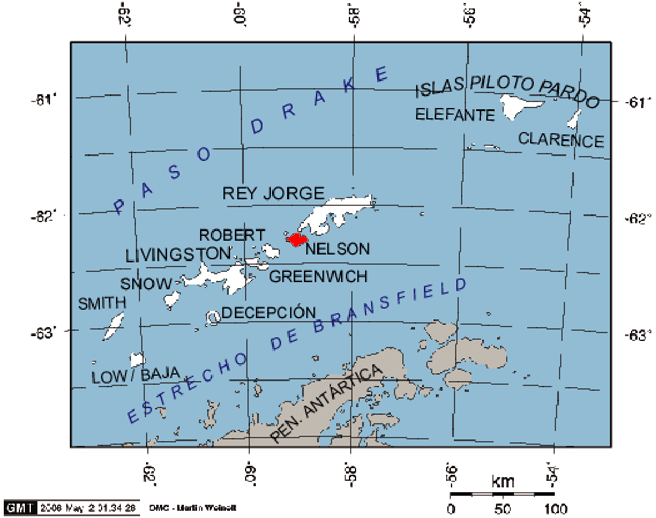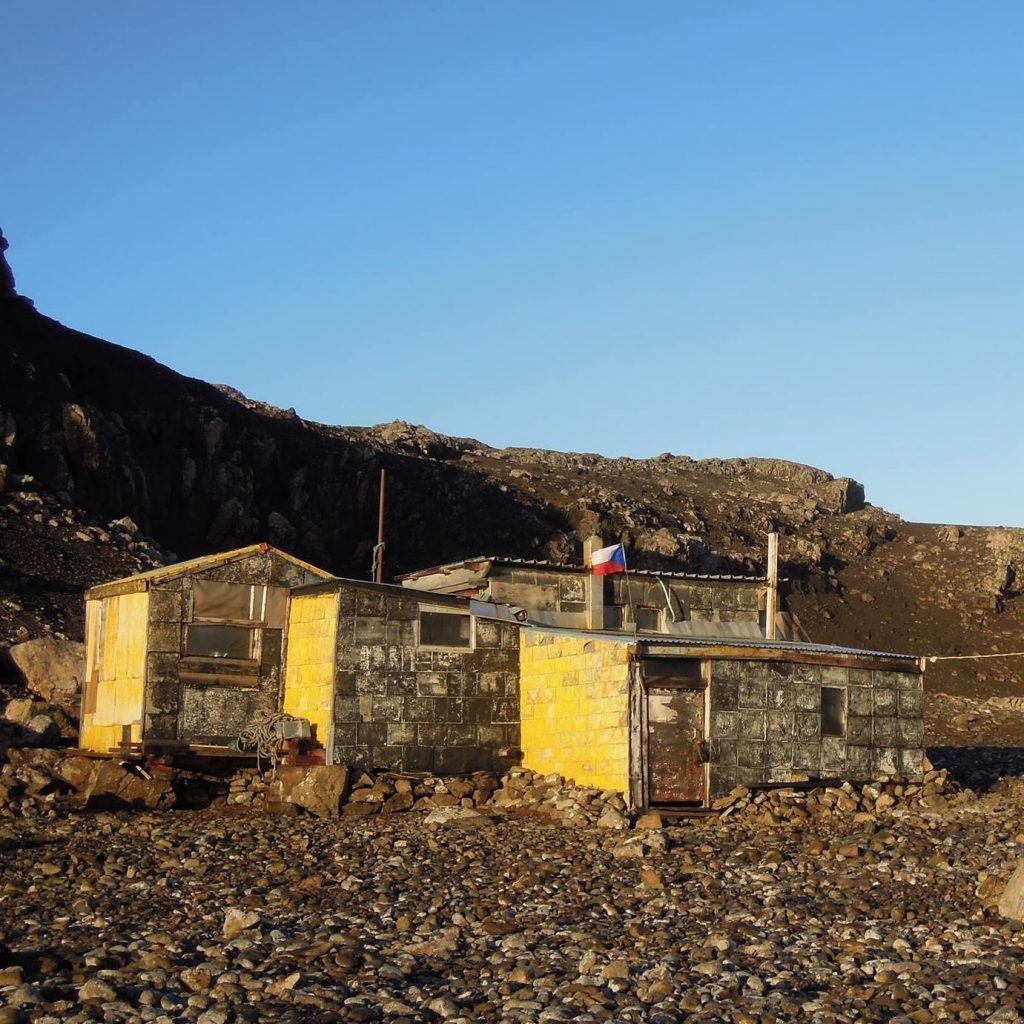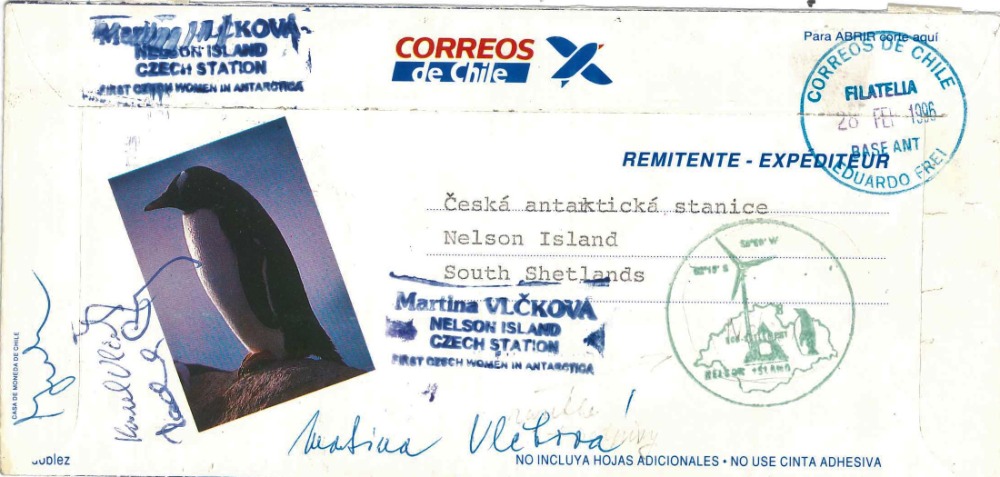CZECH POLAR STATION ON NELSON ISLAND
ANTONÍN BOHÁČEK, JIŘÍ KRAUS
The Czech Republic is located in the heart of Europe. Only rivers, railways, airplanes and the human imagination connect us to the seas and oceans. An unknown man, a Czech mountaineer, traveller, waterman, polar explorer and adventurer Jaroslav Pavlicek came up with the idea how to get his own island and polar station. He took advantage of the wording in the Antarctic Treaty and took one deserted and uninhabited island for Czechoslovakia, establishing a Czech polar station on its free territory, later turned into a small eco-settlement. The remote Nelson Island – Nelson Island – in the South Shetland archipelago is a real polar reserve, whose guardians and only inhabitants were Czechs.
The Czech polar station Václav Vojtěch is located in the North Oasis of Nelson Island at the geographical coordinates 58°59´ W and 62°15´ S. The island is about 20 km long and 15 km wide and covers an area of about 300 km2. The North Oasis is located in the northeast and covers an area of about 8 km2. Oases in Antarctica mean places that are not frozen. The majority of Nelson Island (about 95%) is made up of continental glacier. Only a narrow strip of coastline and 3 oases (East – Duthoit Point, West – Harmony Point and North – Rip Point) remain unglaciated.


Establishment of the Czech polar station
At the end of 1987, the Polish naval ship Antoni Garnuszewski left the port of Gdansk. Its passengers included two adventurers and travellers: Jaroslav Pavlicek and Jan Pávek. The voyage along the route Gdańsk – Baltic Sea – North Sea – Port of Vigo – Atlantic Ocean – Montevideo – South Shetland, King George Island lasted five long weeks. The Czech mini expedition stayed at the destination for only a short time, as it was only “probing the terrain” and looking for a suitable vacant site for the establishment of a polar station. This was found on the neighbouring island of Nelson.
On 28th February 1989, six brave men founded a permanent Czech station named after our most famous polar explorer, Václav Vojtěch. The founders of the polar station were Jaroslav Pavlíček, Jaroslav Fous, Miroslav Jakeš, Jiří Komárek, Martin Kříž and Zdeněk Zamazal.





The Václav Vojtěch Polar Station was a type of pioneer and colonial settlement as we have known it in novels about the settlement of the Wild West. Unlike the luxurious first-class stations, of which there are several on neighbouring King George Island, our station was very modest and low-key. The entire settlement lived a modest, simple life as they mostly followed their own simple eco-programs. A simple wind power station, which was to be used for heating, lighting and water heating, became the dominant feature of the station.
The number of Czech polar explorers gradually inhabiting the cold Nelson has approached 100. One brave Czech woman, Martina Vlčková, joined the brave men. Together with her husband Karel, a mathematics teacher, she stayed on the island for 3 months. The structure of the temporary inhabitants of the Czech eco-settlement was completed by the most diverse professions. The guitarist Lubomír Brabec, the priest Marek Vácha (called Orko), the lawyer Radek Forman, the professional traveller and the photographer Vilém Rudolf stayed there. Only he and Miroslav Jakeš can be proud of one polar record. They had visited also the North Pole of our planet in the past. Among the real scientists were Jiří Komárek, Ľubomír Kováčik (both Slovaks), Martin Kříž, ornithologists Peter Lumpe and Karel Weidinger. The electrical engineer Martin Mykiska spent a whole year here. Jaroslav Fous from Příbram can boast two stays and his first wintering on the island. It was him who first raised the flag on the roof of the station hut. The real doctor Boris Uličný also “wandered” to our island. Nelson’s Island has become a paradise for several Czech businessmen. The president’s sister-in-law, Dáša Havlová, became the most famous visitor. She even tried to visit the island twice, the first time unsuccessfully. The severe winter of 1997 closed the Fildes Strait separating Nelson’s and King George’s Islands, so that an American coastal icebreaker carrying her could not land on the islands because of solid ice.

The Czech polar station was the newest but also the poorest polar station of the whole archipelago. The settlers called it Pavlíčkov after its founder and administrator. The French magazine called the Czechs on the island “Robinsons of Nelson”.
The new century brought many changes to the Nelson eco-station. It was given a website, but interest in its existence somehow faded, perhaps due to the ageing of its founder.
The last noticeable news was that Jaroslav Pavlicek gave his station to the Czech Antarctic Research for a symbolic one crown. In 2020, a group of “Czech-Moravian polar explorers” from Masaryk University in Brno visited Nelson’s Island. They were cleaning up the neglected station and preparing the land for the planned construction of a respectable scientific station. This information is accompanied by an envelope at the end of the article.
Czech Shipping, Air and Polar Mail
The establishment of the station and the settlement is also related to the polar post. The station did not have its own postmark, replaced by a station cachet. A major handicap of the base was the absence of a ship dock. As a result, Václav Vojtěch station was difficult to reach and mail had to be transported to the neighbouring King George Island. This is where the Chilean post office Eduardo Frei (Teniente Rodolfo Marsh) and the Chilean airport serving the entire South Shetland archipelago are located. The mail is regularly transported from here by US HC-130 aircraft to the Chilean city of Punta Arenas (which is the starting point for polar expeditions). Apart from this, the Russians (Bellingshausen station) and the Argentinians (Jubany) also have a post office on King George Island. However, unfortunately, postal connections between these stations and the world are very slow and are made by sea (usually once or twice a year). Therefore, Czech polar explorers and collectors mainly use the services of the Chilean airmail.
Czech polar explorers always had to cross the Fildes Strait separating the two islands with difficulty when travelling to King George Island. Only rarely did Chilean helicopters or Russian amphibian boats transported polar explorers and mail.


Czech canoe on Nelson Island
An interesting feature of the Czech polar mail is that it was regularly transported on a sport canoe until May 1993. It arrived at the Russian station Bellingshausen on board of the expedition ship Akademik Fyodorov on 1st March 1990 and was transported to Nelson’s Island a week later. The founder of this ” shipping ” mail is Jaroslav Fous from Příbram, who together with Jarda Rosák started during 1990 (unfortunately no one recorded the exact date) to transport the mail exclusively on this single canoe (exceptionally also on a kayak) to the next island. Together and inseparably they painted the canoe red and white to represent the Czech national colours and at the same time to make the boat as visible as possible in the icy wasteland. This ” shipping ” post office worked for three years until the 14th May 1993…
In the history of Nelson Island, this day represents a real Black Friday, when 42-year-old Miroslav Stuchlík and 21-year-old Kamil Suchánek disappeared forever. The two experienced polar explorers had regularly crossed the unpredictable Fildes Strait. They were paddling hard in the unclear drift ice from the 12 km distant South Korean station King Sejong towards Nelson Island. But their fate remains unclear. The fact is that both were declared missing and are believed to have drowned in the icy water (-2 °C). We know for certain that both of them carried all their belongings, including cachets, in a rickety boat. The sad end of the Czech canoe mail therefore belongs to this tragic day.


The icebreaker that couldn’t dock in port
The polar lure also brought Dasa Havlová to the Shetlands, a scientist and wife of the brother of the President of the Republic, who visited the archipelago on two trips as a tourist. She first arrived in September 1997 aboard the American icebreaker Nathaniel B. Palmer. The ship first visited the Antarctic Palmer Peninsula, where the USA maintains a permanent Palmer station. However, a landing in the South Shetlands in September 1997 was not possible. Temperatures reached extremes, with -21° C on the Fildes Peninsula and even -55° C in winter. The Czech station was only half a mile from the icebreaker, and still could not be reached.
The second trip was in 2000, when D. Havlová visited several polar stations on King George Island in January and February. Naturally, she also visited the Czech eco-settlement on Nelson Island. The visited stations: the Chilean Presidente Eduardo Frei, where the important Teniente Rodolfo Marsh airport is located, which serves as a year-round air link to South America; the Russian Bellingshausen station, the second largest on King George Island, forms practically a large double settlement with the Chilean village; a postcard from the Chinese Great Wall station confirms the general truth that the Chinese welcoming polar explorers are closest to our settlement in terms of distance and friendliness.





